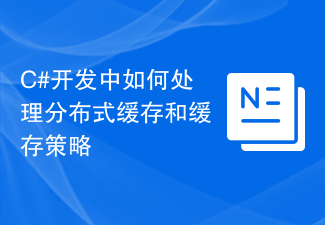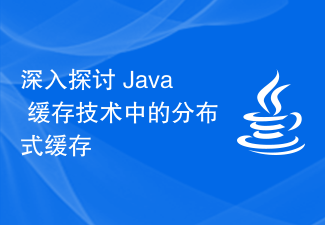 Java
Java javaTutorial
javaTutorial Java development practical experience sharing: building distributed cache consistency function
Java development practical experience sharing: building distributed cache consistency function
Java development practical experience sharing: building distributed cache consistency function
With the development of the Internet, the scale of distributed systems is getting larger and larger, and distributed caches Become an important part of high-performance applications. In distributed cache, ensuring the consistency of cached data is an important issue. This article will share some practical experience in Java development and discuss how to build the consistency function of distributed cache.
1. Problem background
In distributed systems, cache consistency issues are a common and complex challenge. Since the data of the distributed cache is stored on multiple nodes, when one of the nodes fails or the data is updated, data inconsistency may occur. In order to solve this problem, we need to implement a mechanism to ensure that the cache data on all nodes is always consistent.
2. Solution
- Consistent Hash Algorithm
Consistent hash algorithm is a common method to solve the cache consistency problem. It evenly distributes data across nodes by mapping data nodes to a hash ring. When a node fails or the data is updated, the hash value only needs to be recalculated and the data migrated to the new node. This method ensures the consistency of cached data and also ensures load balancing. - Data replication strategy
In distributed cache, you can choose to adopt the master-slave replication or multi-node replication strategy. Master-slave replication means copying data to a master node and multiple slave nodes. When the master node fails, the slave nodes can take over the work of the master node. Multi-node replication copies data to multiple nodes, ensuring data redundancy and high availability. - Data synchronization mechanism
Data synchronization is the key to ensuring the consistency of distributed cache. When data is updated, it is necessary to ensure that the data on all nodes can be updated in time. A common approach is to synchronize data through the publish-subscribe pattern. When the data changes, the master node publishes the message to the subscriber, and the subscriber updates the local cache after receiving the message. - Concurrency control mechanism
In a distributed cache, multiple threads may read and write data at the same time, so a concurrency control mechanism needs to be implemented to ensure data consistency. Commonly used solutions include pessimistic locking and optimistic locking. Pessimistic locking uses an exclusive method to lock data, ensuring that only one thread can access the data at the same time. Optimistic locking checks the version number of the data before performing an update operation. If the version number changes, it means that the data has been modified by other threads and the operation needs to be performed again.
3. Practical Summary
When building a distributed cache consistency function, the following aspects need to be considered:
- High availability: use master-slave replication or Multi-node replication strategy ensures data redundancy and high availability.
- Data synchronization: Use publish-subscribe mode for data synchronization to ensure data consistency among multiple nodes.
- Concurrency control: Use pessimistic locking or optimistic locking to achieve concurrency control to ensure data consistency and concurrency performance.
In actual development, some mature distributed caching frameworks can be used, such as Redis, Memcached, etc. These frameworks already provide some reliable distributed consistency solutions that can quickly build high-performance distributed cache systems.
4. Conclusion
The consistency of distributed cache is a complex issue that requires comprehensive consideration of multiple factors. This article introduces some commonly used solutions and summarizes some practical experiences. I hope it will be helpful to Java developers when building distributed cache consistency functions. Through reasonable architectural design and technology selection, we can build a high-performance, high-availability distributed cache system.
The above is the detailed content of Java development practical experience sharing: building distributed cache consistency function. For more information, please follow other related articles on the PHP Chinese website!
 如何利用Redis和Node.js实现分布式缓存功能Sep 21, 2023 pm 02:30 PM
如何利用Redis和Node.js实现分布式缓存功能Sep 21, 2023 pm 02:30 PM如何利用Redis和Node.js实现分布式缓存功能Redis是一个开源的内存数据库,其提供了快速可扩展的键值存储,常用于缓存、消息队列和数据存储等场景。Node.js是一个基于ChromeV8引擎的JavaScript运行时,适用于高并发的Web应用。本文将介绍如何使用Redis和Node.js来实现分布式缓存功能,通过具体的代码示例帮助读者理解和实践。
 PHP和REDIS:如何实现分布式缓存失效与更新Jul 21, 2023 pm 05:33 PM
PHP和REDIS:如何实现分布式缓存失效与更新Jul 21, 2023 pm 05:33 PMPHP和REDIS:如何实现分布式缓存失效与更新引言:在现代的分布式系统中,缓存是一个非常重要的组件,它可以显著提高系统的性能和可扩展性。与此同时,缓存的失效与更新也是一个非常重要的问题,因为如果无法正确地处理缓存数据的失效与更新,就会导致系统数据的不一致。本文将介绍如何使用PHP和REDIS实现分布式缓存失效与更新,同时提供相关的代码示例。一、什么是RED
 C#开发中如何处理分布式缓存和缓存策略Oct 08, 2023 pm 11:36 PM
C#开发中如何处理分布式缓存和缓存策略Oct 08, 2023 pm 11:36 PMC#开发中如何处理分布式缓存和缓存策略引言:在当今高度互联的信息时代,应用程序的性能和响应速度对于用户的体验至关重要。而缓存是提高应用程序性能的重要方法之一。在分布式系统中,处理缓存和制定缓存策略变得尤为重要,因为分布式系统的复杂性往往会带来额外的挑战。本文将探讨C#开发中如何处理分布式缓存和缓存策略,并通过具体的代码示例展示实现方式。一、使用分布式缓存引入
 使用go-zero实现高可用性的分布式缓存Jun 23, 2023 am 08:02 AM
使用go-zero实现高可用性的分布式缓存Jun 23, 2023 am 08:02 AM随着Web应用程序的发展,越来越多的关注点开始转向于如何提高应用程序的性能。而缓存的作用在于抵消高流量和繁忙负载,提高Web应用程序的性能和可伸缩性。在分布式环境下,如何实现高可用性的缓存就成为了一项重要的技术。本文将介绍如何使用go-zero提供的一些工具和框架来实现高可用性的分布式缓存,并简单讨论下go-zero在实际应用中的优势和限制。一、什么是go-
 C#开发中如何处理分布式事务和分布式缓存Oct 08, 2023 pm 08:01 PM
C#开发中如何处理分布式事务和分布式缓存Oct 08, 2023 pm 08:01 PMC#开发中如何处理分布式事务和分布式缓存,需要具体代码示例摘要:在分布式系统中,事务处理和缓存管理是至关重要的两个方面。本文将介绍C#开发中如何处理分布式事务和分布式缓存,并给出具体的代码示例。引言随着软件系统的规模与复杂度增加,许多应用都采用了分布式架构。在分布式系统中,事务处理和缓存管理是两个关键的挑战。事务处理确保了数据的一致性,而缓存管理则提高了系统
 利用Redis实现分布式缓存穿透解决方案Nov 07, 2023 am 10:26 AM
利用Redis实现分布式缓存穿透解决方案Nov 07, 2023 am 10:26 AM利用Redis实现分布式缓存穿透解决方案随着互联网业务的不断发展,数据访问量也在不断增加,为了提高系统的性能和用户体验,缓存技术逐渐成为了必不可少的一部分,其中Redis作为一种高效、可扩展的缓存中间件方案,备受开发者的青睐。在使用Redis作为分布式缓存时,为了避免缓存穿透而产生的性能问题,我们需要实现一种可靠的解决方案。本文将介绍如何利用Redis实现分
 深入探讨 Java 缓存技术中的分布式缓存Jun 21, 2023 am 09:00 AM
深入探讨 Java 缓存技术中的分布式缓存Jun 21, 2023 am 09:00 AM在当前互联网高并发和大数据的环境下,缓存技术成为了提升系统性能的重要手段之一。在Java缓存技术中,分布式缓存是一种非常重要的技术。那么什么是分布式缓存呢?本文将深入探讨Java缓存技术中的分布式缓存。一、分布式缓存的基本概念分布式缓存是指将缓存数据存储在多个节点上的缓存系统。其中,每个节点都包含着完整的缓存数据副本,可以相互备份,当其中一个节点失效
 如何使用PHP微服务实现分布式缓存预热和更新Sep 24, 2023 am 11:33 AM
如何使用PHP微服务实现分布式缓存预热和更新Sep 24, 2023 am 11:33 AM如何使用PHP微服务实现分布式缓存预热和更新引言:在现代的Web应用中,缓存是提高性能和减少数据库负载的重要技术手段之一。而分布式缓存则能进一步提升系统的可伸缩性和抗压能力。本文将介绍如何使用PHP微服务来实现分布式缓存的预热和更新,并提供一些具体的代码示例。需求分析:我们的目标是通过微服务来实现两个关键功能:缓存预热:在系统启动时,从数据库中获取数据,并将


Hot AI Tools

Undresser.AI Undress
AI-powered app for creating realistic nude photos

AI Clothes Remover
Online AI tool for removing clothes from photos.

Undress AI Tool
Undress images for free

Clothoff.io
AI clothes remover

AI Hentai Generator
Generate AI Hentai for free.

Hot Article

Hot Tools

PhpStorm Mac version
The latest (2018.2.1) professional PHP integrated development tool

VSCode Windows 64-bit Download
A free and powerful IDE editor launched by Microsoft

WebStorm Mac version
Useful JavaScript development tools

Dreamweaver CS6
Visual web development tools

SublimeText3 Mac version
God-level code editing software (SublimeText3)





